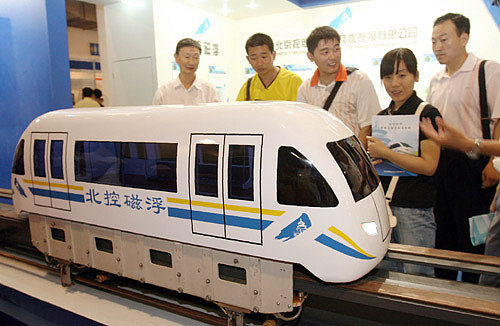|
 |
|
MAGLEV MANIA: Visitors watch a high-speed maglev train model of the Beijing Enterprises Holdings Maglev Technology Development Co. Ltd. at the China (Beijing) International Transport and Municipal Facilities Exhibition in August 2009 (XINHUA) |
Noise from passing maglev trains was also addressed in the letter. Many claim the noise from a passing maglev train is more annoying than that of a wheeled train.
Residents also said they are hesitant to believe that maglev trains will not bother those along train routes with jarring or jolting. The absence of jarring is only theoretical, based on statistics from experiments conducted in an environment without vehicles, residents or factories, they said in the letter.
Instead, the residents proposed paving rails underground for wheeled trains as an alternative to the S1 Line.
Safe design
Beijing Enterprises Holdings Maglev Technology Development Co. Ltd. will provide the technology for the Chinese capital's fist maglev line. The company completed research and development work with nearly 40 million yuan ($5.86 million) in funds from the Beijing Municipal Science and Technology Commission.
In 2008, the company built a 1.547-km low-speed maglev test line in Tangshan, Hebei Province, and tested it with an economical maglev train.
The train was approved by a team of experts and passed four tests from the CAS Institute of Electrical Engineering (IEE) and Beijing Municipal Environmental Monitoring Center on March 5, 2010.
Magnetic radiation intensity from a low-to-medium-speed maglev train is lower than the safety standard set by the International Commission on Non-Lonizing Radiation Protection and is about the same as that from wheeled trains running on rails, a report issued by the team of experts said.
"The radiation from a low-to-medium-speed maglev train is safe enough for people to use, because, broadly speaking, we are already living in an electromagnetic environment," said Sun Guangsheng, a researcher with the Bioelectromagnetics Lab under the IEE of the CAS and one of the experts involved in analyzing the Tangshan test line.
While household lights generally operate on at least 50 hz, the maglev train has a frequency high of 90 hz. The electromagnetic radiation is also "sealed," Sun said.
Passengers don't have to worry about the radiation because the radiation within the maglev train is about the same as that from a hair dryer or an electric razor, said Cong Chunshui, a senior engineer with Beijing Enterprises Holdings, to Beijing Review.
In terms of the noise, Liu Zhiming, Chairman of Beijing Enterprises Holdings, said it is about 64 db 10 meters from the rail, which is lower than the 92 db from a light rail train.
The test states that the S1 Line maglev train meets national standards for magnetic radiation and noise, according to the Beijing Infrastructure Investment Co. Ltd.
Concessions
The wide dispute over the maglev's safety has postponed the public hearing slated to conclude later this month.
A CARS researcher said the expert team is investigating the issues brought up by residents and will publish their findings in a second report. No timetable has been set for the follow-up report.
But residents have won a small victory in their fight against the fast train: on May 12, the EAEC of the CARS issued a notice on its website, saying the length of the project's underground section would be extended from 455 meters to 2,969 meters.
The underground extension will cause a smaller population to be affected, but will still leave the two compounds of Bisenli and China House on the maglev's proposed path.
Zhao and his neighbors are decided in their resistance and will continue to send letters to relevant administrations.
"Maglev trains haven't been put into wide application overseas despite numerous demonstrations. So why should China promote it so hastily?" Zhao said.
The Maglev Line to Be Constructed in Beijing
With a total length of 19.869 km and 12 stations, the project runs eastward to Cishousi Station in Haidian District from Shimenying Station in Mentougou District in southwest Beijing.
Divided into two sections for easier construction, the project will begin land acquisition and resettlement work from the west section, starting September 1, 2010. The west section, from Shimenying Station to Pingguoyuan Station, is slated to be ready for trial operation by December 2013. The east section, from Pingguoyuan Station to Cishousi Station, will begin construction in November 2013, with a trial operation in February 2017.
(Source: The Chinese Academy of Railway Sciences)
The Maglev Line Now Operates in Shanghai
Shanghai boasts China's only current maglev line, with a total investment of 10.03 billion yuan ($1.47 billion). The 30 km-long maglev line was built using German technologies and has a high speed of 431 km per hour.
Approved for construction in June 2000, the Shanghai Maglev Line was completed on December 31, 2002, launched on October 11, 2003, and examined and accepted by the government on April 26, 2007.
Designed to have a daily passenger turnover of 23,000, the line now sees less than 5,000 passengers due to high ticket prices. Price cuts in recent years haven't helped boost passenger turnover.
The line cost nearly 1 billion yuan ($146.4 million) for equipment updating by the end of 2009. The line has been operated at an annual loss of 500-700 million yuan ($73.2-102.5 million), with accumulated debts of more than 7 billion yuan ($1 billion).
(Source: edited by Beijing Review) | 